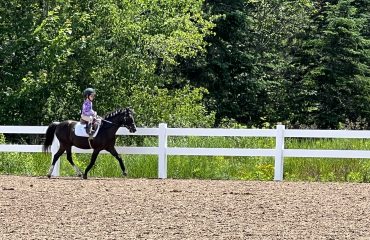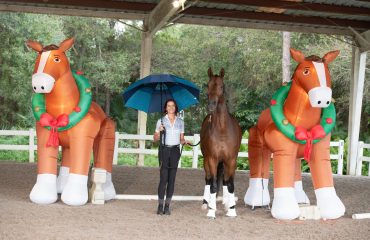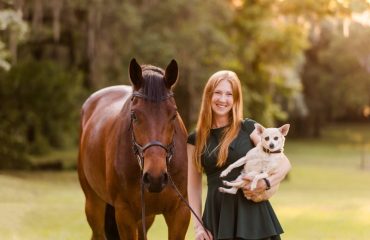We aren’t sure what the fox says, but foxhunters say, “Tally Ho!” Learn all about the thrill of foxhunting from a rider who is hooked on the sport.
By Doris Degner-Foster
The “music” of baying hounds is heard throughout the woods. The riders move off at a gallop and you try to watch for jumps through eyes beginning to water from the wind in your face. Ahead of you and the field master, the huntsman is blowing his horn to encourage the hounds. You wonder vaguely how anyone can hold reins and a hound whip and still manage to blow a horn while riding a horse this fast. You are too busy to do anything else but hold on and keep up, and you try not to think about what might happen at this speed if your horse puts a foot wrong. The realization that you are smiling widely is suddenly clear as you taste mud in your teeth, kicked up from horses ahead of you. You have instantly become hooked on this sport.
I wish I could simply tell you about foxhunting, but the emotions get in the way and refuse to stay quiet. Foxhunters are an enthusiastic, passionate group who share a physical toughness, a love for animals and the land, and they just seem to have a kind of zest for life.
Everyone in the hunt field is on equal footing, literally and figuratively. Those riders who have kept up and are still on their horse at the end of a hard, fast run share mutual respect. Author and Master of Oak Ridge Hunt, Rita Mae Brown has said, “The great thing about hunting is someone worth a few million dollars might be riding right next to someone who makes twenty-three thousand dollars a year, and no one cares. Foxhunters cut across ethnic and class lines, all professions, all ages. It doesn’t matter how rich you are, you still have to ride the horse, and you can’t buy your way over the fence.”

The field of riders of Harvard Fox Hounds returning from an opening hunt.
Photo by Lisa Jewel at artbyjewell.com
Families often ride in the hunt field together with the youngest members on ponies being ponied, or led from another horse by a parent. At the Devon Horse Show, there are classes where families compete together. Foxhunting is a sport anyone from kids to retirees can enjoy.
The sport of hunting with hounds has existed in the United States since the 1700’s. George Washington kept a pack of hunting hounds at Mount Vernon where Thomas Jefferson was often a guest. Hunting parties there are said to have lasted for weeks on end. At present, the Masters of Fox Hounds Association, the governing body of foxhunting in North America, lists 159 registered packs in the U.S. and Canada. There are also many unregistered informal packs, known as farm packs, throughout North America. Foxhunting is also known as fox chasing, which is a more accurate name since foxes are not hunted and killed, only chased.
The individuals riding with the hunt are led by a field master who keeps up with the action so that riders may watch the hounds and even possibly get a glimpse of the fox or coyote, an event in which it is proper to shout, “Tally Ho!” Foxes are chased in the eastern part of the U.S. and coyotes in the Midwest and western part of the U.S. The first field master follows the huntsman who, with the help of other staff members called whippers-in or whips, follows the hounds as they seek the scent line of the fox or coyote.
The first field is also known as first flight because it can seem like flying when galloping fast to keep up with the hounds. Most hunts have a second field, which moves along at a slower pace and doesn’t jump, and some hunts have an even slower group known as third field. Riding in second or third field is also known as hill topping and a good place to begin foxhunting. The second field master can often point out the action and explain what is happening if they are not too close to the huntsman or first field. Conversation is not allowed in the first field since it is a distraction to hounds and the huntsman, who is listening for the hounds to “open” or begin baying when they find a scent.
An advantage to foxhunting is that horses learn to carry themselves over uneven terrain at a gallop and to deal with any hazards on their own. At times, too much interference from a rider can actually be counterproductive.
An experienced hunt horse can be depended upon to think for himself and is well equipped to carry a rider over unfamiliar terrain at speed. Former world champion eventer Lucinda Green would often take her young horses hunting. Galloping in the hunt field as part of a young horse’s schooling can make him safer to ride in the cross-country phase of eventing. Horses learn to react quickly on their own if they come across unexpected situations, instead of waiting for instructions from a rider. In the hunt field, it is common to see a master or whipper-in galloping along on relatively loose reins as they are blowing a horn or talking on their radio to other staff members, leaving it up to the horse to pick the safest way over the terrain.
People who foxhunt are sometimes older individuals from varied backgrounds. Many have come into riding later in life or from other horse sports, and they all share a physical toughness, a deep love of the outdoors and a thirst for thrill. People in their 60’s, 70’s and even 80’s enjoy hunting. The option of riding in second or third field ensures a place for a rider of almost any skill level or ability. A sense of humor helps, too, especially during those times when mud is flying, or when one lands unexpectedly in the dirt.
With the love of nature, foxhunters tend to be conservationists. The most obvious reason being that if they were not, there soon wouldn’t be land upon which to hunt, but there is more than just that. A foxhunter cares deeply about the land and the wild animals there or they wouldn’t spend so much time out in it. It is common for hunt masters and staff to monitor the welfare of foxes on the land where they hunt. They sometimes put out dry pet food for them, occasionally with wormer in it to protect the health of the foxes.
Many hunters who own land have set up conservation easements through the Land Trust Alliance where the land continues as farm or ranch land permanently and cannot be developed. This is especially helpful on tracts of land that are under intense development pressure in the eastern part of the U.S. The landowner continues to own and manage the land subject to the restrictions contained in the conservation easement.
The social aspect of the hunt is very important as it heightens the excitement when others are also present to see the fox or coyote, and to watch the hounds working the line of scent. The experience is often relived during the hunt breakfast, a meal eaten after the hunt regardless of the time of day. Hunt breakfasts can range from elaborate affairs in manor houses with crystal, silver and china to tailgate picnics in the field. Regardless of the setting, even when people are from different generations and backgrounds, sharing the thrill of the hunt and laughing together about mud spattered faces has been the basis for many lifelong friendships.
About the writer: Doris Degner-Foster lives in Tulsa, Oklahoma and rides with Harvard Fox Hounds when she is not interviewing interesting individuals in the horse sport. She also enjoys writing fiction and is working on a middle grade book series about teenagers who ride horses and solve mysteries. Doris also writes the “Notes From The Field” blog on the Sidelines Magazine website – don’t miss it!















